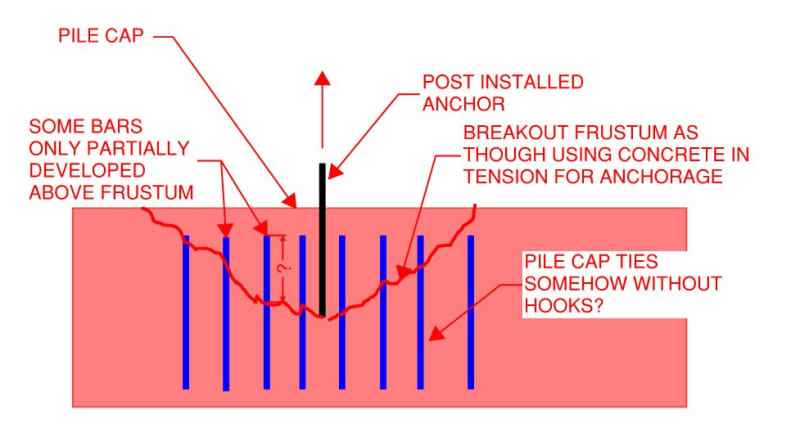I received a call from site, and the cast-in-place anchors I've designed and detailed were embedded too far into a pile cap. The result is we're cutting and abandoning the four cast-in-place anchors (unweldable) in favour of post-installed bars installed using epoxy. The cast-in-place anchors would fully develop the longitudinal bars in the pile cap, but even a 25" embeddment for post-installed bars will partially develop some longitudinal bars. The longitudinal bars are not hooked at the top (which would have been a good idea in hind site). I think I have a work around, but I've stumbled on an interesting question in this process. Can one partially develop a bar? I didn't find any CSA A23 data to support partial development.
For example, let's say the full development length of a 15M bar was 390mm in 30MPa concrete with k1*k2*k3=1.0. Then let's say I install an anchor bolt and calculate the failure plane to interact with this lone bar at 195mm (50% of the development length). May I use 50% of the bar's tension resistance in addition to the tensile resistance of the adjacent concrete (as we would for unreinforced concrete)? Is the relationship between partial development linear? Are there any standards, codes, research, or past experiences to reference these scenarios?
I would love to hear everyone's comments. Thank you in advance for any information.
PC
For example, let's say the full development length of a 15M bar was 390mm in 30MPa concrete with k1*k2*k3=1.0. Then let's say I install an anchor bolt and calculate the failure plane to interact with this lone bar at 195mm (50% of the development length). May I use 50% of the bar's tension resistance in addition to the tensile resistance of the adjacent concrete (as we would for unreinforced concrete)? Is the relationship between partial development linear? Are there any standards, codes, research, or past experiences to reference these scenarios?
I would love to hear everyone's comments. Thank you in advance for any information.
PC

